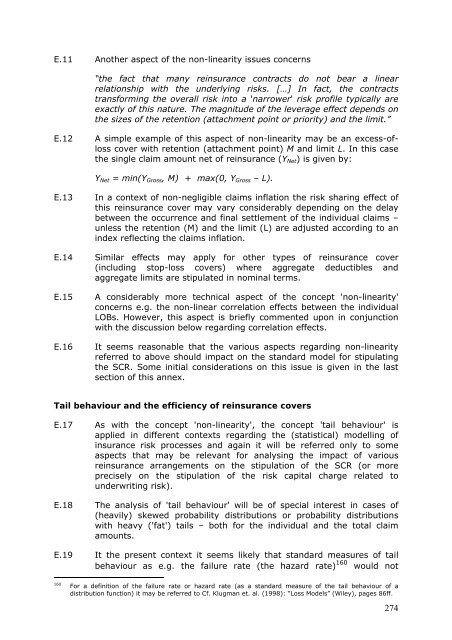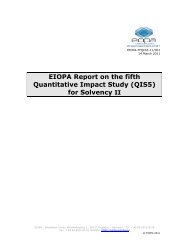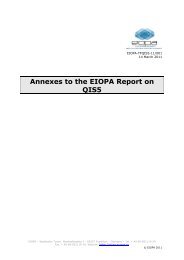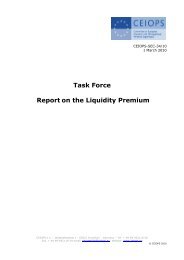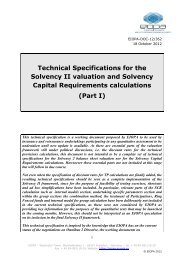Answers to the European Commission on the ... - Eiopa - Europa
Answers to the European Commission on the ... - Eiopa - Europa
Answers to the European Commission on the ... - Eiopa - Europa
You also want an ePaper? Increase the reach of your titles
YUMPU automatically turns print PDFs into web optimized ePapers that Google loves.
E.11 Ano<str<strong>on</strong>g>the</str<strong>on</strong>g>r aspect of <str<strong>on</strong>g>the</str<strong>on</strong>g> n<strong>on</strong>-linearity issues c<strong>on</strong>cerns<br />
“<str<strong>on</strong>g>the</str<strong>on</strong>g> fact that many reinsurance c<strong>on</strong>tracts do not bear a linear<br />
relati<strong>on</strong>ship with <str<strong>on</strong>g>the</str<strong>on</strong>g> underlying risks. […] In fact, <str<strong>on</strong>g>the</str<strong>on</strong>g> c<strong>on</strong>tracts<br />
transforming <str<strong>on</strong>g>the</str<strong>on</strong>g> overall risk in<str<strong>on</strong>g>to</str<strong>on</strong>g> a 'narrower' risk profile typically are<br />
exactly of this nature. The magnitude of <str<strong>on</strong>g>the</str<strong>on</strong>g> leverage effect depends <strong>on</strong><br />
<str<strong>on</strong>g>the</str<strong>on</strong>g> sizes of <str<strong>on</strong>g>the</str<strong>on</strong>g> retenti<strong>on</strong> (attachment point or priority) and <str<strong>on</strong>g>the</str<strong>on</strong>g> limit.”<br />
E.12 A simple example of this aspect of n<strong>on</strong>-linearity may be an excess-ofloss<br />
cover with retenti<strong>on</strong> (attachment point) M and limit L. In this case<br />
<str<strong>on</strong>g>the</str<strong>on</strong>g> single claim amount net of reinsurance (YNet) is given by:<br />
YNet = min(YGross, M) + max(0, YGross – L).<br />
E.13 In a c<strong>on</strong>text of n<strong>on</strong>-negligible claims inflati<strong>on</strong> <str<strong>on</strong>g>the</str<strong>on</strong>g> risk sharing effect of<br />
this reinsurance cover may vary c<strong>on</strong>siderably depending <strong>on</strong> <str<strong>on</strong>g>the</str<strong>on</strong>g> delay<br />
between <str<strong>on</strong>g>the</str<strong>on</strong>g> occurrence and final settlement of <str<strong>on</strong>g>the</str<strong>on</strong>g> individual claims –<br />
unless <str<strong>on</strong>g>the</str<strong>on</strong>g> retenti<strong>on</strong> (M) and <str<strong>on</strong>g>the</str<strong>on</strong>g> limit (L) are adjusted according <str<strong>on</strong>g>to</str<strong>on</strong>g> an<br />
index reflecting <str<strong>on</strong>g>the</str<strong>on</strong>g> claims inflati<strong>on</strong>.<br />
E.14 Similar effects may apply for o<str<strong>on</strong>g>the</str<strong>on</strong>g>r types of reinsurance cover<br />
(including s<str<strong>on</strong>g>to</str<strong>on</strong>g>p-loss covers) where aggregate deductibles and<br />
aggregate limits are stipulated in nominal terms.<br />
E.15 A c<strong>on</strong>siderably more technical aspect of <str<strong>on</strong>g>the</str<strong>on</strong>g> c<strong>on</strong>cept 'n<strong>on</strong>-linearity'<br />
c<strong>on</strong>cerns e.g. <str<strong>on</strong>g>the</str<strong>on</strong>g> n<strong>on</strong>-linear correlati<strong>on</strong> effects between <str<strong>on</strong>g>the</str<strong>on</strong>g> individual<br />
LOBs. However, this aspect is briefly commented up<strong>on</strong> in c<strong>on</strong>juncti<strong>on</strong><br />
with <str<strong>on</strong>g>the</str<strong>on</strong>g> discussi<strong>on</strong> below regarding correlati<strong>on</strong> effects.<br />
E.16 It seems reas<strong>on</strong>able that <str<strong>on</strong>g>the</str<strong>on</strong>g> various aspects regarding n<strong>on</strong>-linearity<br />
referred <str<strong>on</strong>g>to</str<strong>on</strong>g> above should impact <strong>on</strong> <str<strong>on</strong>g>the</str<strong>on</strong>g> standard model for stipulating<br />
<str<strong>on</strong>g>the</str<strong>on</strong>g> SCR. Some initial c<strong>on</strong>siderati<strong>on</strong>s <strong>on</strong> this issue is given in <str<strong>on</strong>g>the</str<strong>on</strong>g> last<br />
secti<strong>on</strong> of this annex.<br />
Tail behaviour and <str<strong>on</strong>g>the</str<strong>on</strong>g> efficiency of reinsurance covers<br />
E.17 As with <str<strong>on</strong>g>the</str<strong>on</strong>g> c<strong>on</strong>cept 'n<strong>on</strong>-linearity', <str<strong>on</strong>g>the</str<strong>on</strong>g> c<strong>on</strong>cept 'tail behaviour' is<br />
applied in different c<strong>on</strong>texts regarding <str<strong>on</strong>g>the</str<strong>on</strong>g> (statistical) modelling of<br />
insurance risk processes and again it will be referred <strong>on</strong>ly <str<strong>on</strong>g>to</str<strong>on</strong>g> some<br />
aspects that may be relevant for analysing <str<strong>on</strong>g>the</str<strong>on</strong>g> impact of various<br />
reinsurance arrangements <strong>on</strong> <str<strong>on</strong>g>the</str<strong>on</strong>g> stipulati<strong>on</strong> of <str<strong>on</strong>g>the</str<strong>on</strong>g> SCR (or more<br />
precisely <strong>on</strong> <str<strong>on</strong>g>the</str<strong>on</strong>g> stipulati<strong>on</strong> of <str<strong>on</strong>g>the</str<strong>on</strong>g> risk capital charge related <str<strong>on</strong>g>to</str<strong>on</strong>g><br />
underwriting risk).<br />
E.18 The analysis of 'tail behaviour' will be of special interest in cases of<br />
(heavily) skewed probability distributi<strong>on</strong>s or probability distributi<strong>on</strong>s<br />
with heavy ('fat') tails – both for <str<strong>on</strong>g>the</str<strong>on</strong>g> individual and <str<strong>on</strong>g>the</str<strong>on</strong>g> <str<strong>on</strong>g>to</str<strong>on</strong>g>tal claim<br />
amounts.<br />
E.19 It <str<strong>on</strong>g>the</str<strong>on</strong>g> present c<strong>on</strong>text it seems likely that standard measures of tail<br />
behaviour as e.g. <str<strong>on</strong>g>the</str<strong>on</strong>g> failure rate (<str<strong>on</strong>g>the</str<strong>on</strong>g> hazard rate) 160 would not<br />
160 For a definiti<strong>on</strong> of <str<strong>on</strong>g>the</str<strong>on</strong>g> failure rate or hazard rate (as a standard measure of <str<strong>on</strong>g>the</str<strong>on</strong>g> tail behaviour of a<br />
distributi<strong>on</strong> functi<strong>on</strong>) it may be referred <str<strong>on</strong>g>to</str<strong>on</strong>g> Cf. Klugman et. al. (1998): “Loss Models” (Wiley), pages 86ff.<br />
274


